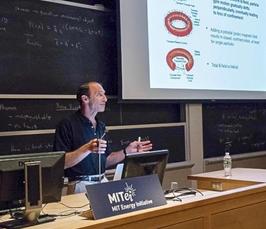The SPARC tokamak: the high-field path to fusion energy
Institutskolloquium
- Datum: 29.01.2021
- Uhrzeit: 15:00 - 16:30
- Vortragender: Dr. Robert Granetz
- Dr. Granetz is a principal research scientist at the MIT Plasma Science and Fusion Center. His main areas of research include MHD equilibrium and stability, disruptions, and disruption mitigation studies, both on the Alcator series of high-field tokamaks at MIT, and through collaborations on other major tokamaks around the world. Dr. Granetz has also taught graduate student courses in plasma physics and fusion for the Physics Department and Nuclear Science and Engineering Department at MIT. He spent 2.5 years in Europe as a visiting scientist on the Joint European Torus (JET). He has also participated extensively on ITER advisory groups on MHD and disruption issues. Currently, Dr. Granetz is also part of a privately funded program at MIT to incorporate high-temperature superconductors into high field magnets for use in the SPARC tokamak, as well as future tokamak and stellarator reactors. Dr. Granetz received his undergraduate and graduate degrees at MIT, doing his doctoral thesis research on the early Alcator tokamaks
- Ort: Zoom Meeting Room 1
- Gastgeber: Dmitry Moseev
- Kontakt: dmitry.moseev@ipp.mpg.de

The SPARC mission is to create and confine a plasma that produces net fusion energy for the first time. High-temperature, high-field superconductors (REBCO) are the fundamental technology that enables SPARC to be built at a smaller scale compared to other proposed net-energy tokamaks; the smaller scale also enables it to be completed on a faster timeline. We are currently in Phase 1 of the SPARC project, with two major milestones due in the summer of 2021:
(1) design, construction, and operation of a SPARC prototypical toroidal field coil, and
(2) a ready-to-construct engineering design of the SPARC tokamak and facility.
Early R&D was very successful, proving the robust performance of REBCO superconductor under SPARC-relevant conditions. The team has designed the toroidal field model coil, and it is currently under construction. Successful test results next summer will retire most of the major risks of the SPARC magnet system. In parallel, the physics and engineering of the SPARC device have been progressing to a self-consistent design, with all major systems specified, and predicted plasma performance having a robust margin to engineering limits.
Research Supported by Commonwealth Fusion Systems